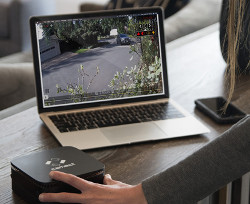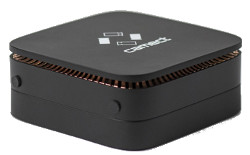Linux-powered NVR can stream and analyze 12 HD cam feeds without a cloud connection
Sep 19, 2019 — by Eric Brown 3,214 views [Updated: 3:45PM] — A new “Camect” camera hub and 1TB NVR that can aggregate up to 12 HD streams has funded on Indiegogo. The $279 device runs Linux on an Apollo Lake SoC and provides AI algorithms to analyze video without a cloud service.
[Updated: 3:45PM] — A new “Camect” camera hub and 1TB NVR that can aggregate up to 12 HD streams has funded on Indiegogo. The $279 device runs Linux on an Apollo Lake SoC and provides AI algorithms to analyze video without a cloud service.
A Mountain View-based startup called Camect has successfully launched an Apollo Lake-based, AI-enabled camera hub and network video recorder for analyzing surveillance feeds. After more than quintupling its $50K Indiegogo goal, the Camect is available for another 15 days in $279 early bird packages, down from the eventual $399 when it ships in January.


Camect with web browser (left) and mobile app
(click images to enlarge)
The Camect can aggregate and analyze up to a dozen 1080p video streams from over 50 different home security camera brands including Axis, Amcrest, Dahua, Hikvision, Foscam, Nest, and Reolink. The system operates without a cloud service, thereby avoiding security and privacy issues — at least those not instigated by the user. You can buy a $499 Lifetime Service package — or a $60 per year subscription for the basic model — that provides a variety of Internet-related services, although the device can operate without an Internet connection.
The Camect supports up to 24-megapixels of total streaming video, which translates into 12 HD cameras, 24 720p cameras, 3x 4K cameras, or a mixture in between. Pan/tilt/zoom support and automatic configuration are available for selected cameras.
— ADVERTISEMENT —
As noted in the CNXSoft report that alerted us to the product, the Camect hardware is based on an AcePC AK1 mini-PC that appears to have been phased out for a similarly Windows-equipped, $190 AK2 model. Note, however, that the $190 price does not include the 1TB HDD, which would add up to $50.
The Camect model has been modified internally, however, and improved to eliminate EC bugs and reduce the chance of overheating under high load. Although there’s no mention of it on the Indiegogo page, an email response from Camect co-founder Arup Mukherjee confirms that it runs Linux.
Mukherjee, who like co-founder Chao Liu is a Google alum, notes that “The AI is all software …. tensorflow + SSD + MobileNet + a lot of optimizations we did to make everything run smoothly on a small box, and a model that we have trained ourselves.” Mukherjee adds: “We sell hardware rather than software because it’s quite tricky to get a hardware + software combination that works well under load.”

Some cameras supported by Camect
(click image to enlarge)
The basic $279 package provides smart local video recorder functions for all connected cameras including continuous recording, Smart Alert detection, live view, playback, and review of smart alerts via a mobile app or web browser. It also includes the “Internet” features found in the $60 yearly subscription or Lifetime Service model for two cameras only.
The subscription extends the Internet features to up to five connected cameras. The features include delivery of Smart Alerts by email, instant message, or Android app notification, as well as remote live view and playback of all the cameras. The service can also integrate with cloud-based systems like Alexa and Google Home and enable saving a copy of each Smart Alert to Dropbox. You can also interact with an online community of Camect users.
The subscription service enables sharing functions ranging from sharing clips to full camera access. Yet beyond these voluntary sharing features there appears to be no storage or streaming of local video to the cloud unless you choose to do so separately using Google Drive, Dropbox, or YouTube.
Camect promises that its AI software is smart enough to avoid “annoying, unneeded alerts.” The algorithms analyze motion and can identify the moving object. The AI can learn to discriminate, for example, between people walking down the sidewalk past your house vs. those coming to the door — or sorting out dogs and passing cars from selected objects of interest. It can also discriminate between different animals and vehicles and even identify different delivery service trucks.
Camect hardware
The AK1-based Camect box runs Linux on a quad-core Intel Celeron J3455 (1.5/2.3GHz) from the Apollo Lake generation. The SoC has a 10W TDP, and the whole system consumes 15W.
The 5.0 x 5.0 x 2.0-inch device ships with 4GB of RAM and a 1TB HDD, and you can extend the storage to up to 2TB by attaching drives to the two USB 3.0 ports. NAS storage is also supported.


Camect and detail view
(click images to enlarge)
The Camect provides a GbE port, but there’s no built-in PoE, so you’ll need to buy a PoE switch if you need to connect PoE-powered cameras. There’s also dual-band 802.11ac (with Bluetooth 4.0) for connecting to typical home surveillance cameras.
The system provides an HDMI port, but it’s used for diagnostic purposes only — the video streams to your mobile or web app. It’s unclear whether the additional ports shown in the photos but not listed by Camect are active. The AK1 model it’s based on provides 32GB flash, a microSD slot, 2x USB 2.0 ports, a USB Type-C port, and an audio jack.
Camect is not an open source hardware project, but it does offer a path toward hackability. The company has developed an API, which it it has used to implement an “experimental” integration with the Python-oriented Home Assistant home automation platform. Files are posted on GitHub, here and here.
Further information
The Camect is available on Indiegogo for another 15 days for $279 or $499 with a lifetime subscription with full Internet services. Otherwise, the subscription starts at $60 per year. Shipping in the U.S. costs $5, and shipments are due in January, although many of the customers who ordered in the first few weeks will receive units as early as October. More information may be found on the Camect Indiegogo page and Camect website.

This seems to be pretty promising infrastructure, A very cost effective solution. The specs are impressive. The question is will it live up to expectation.